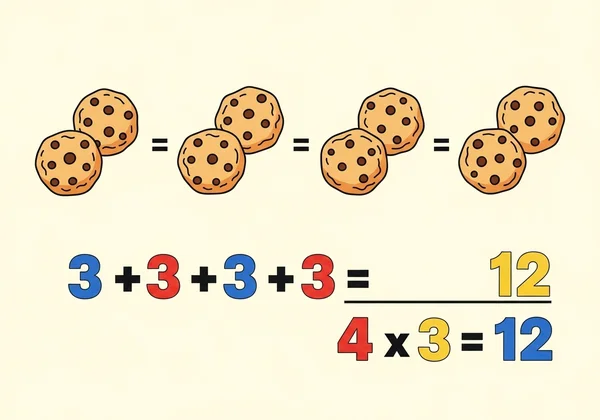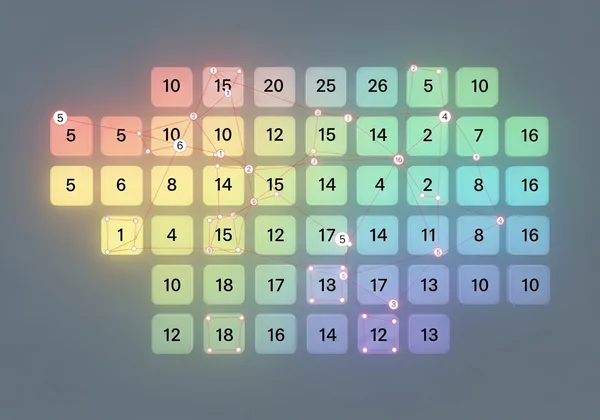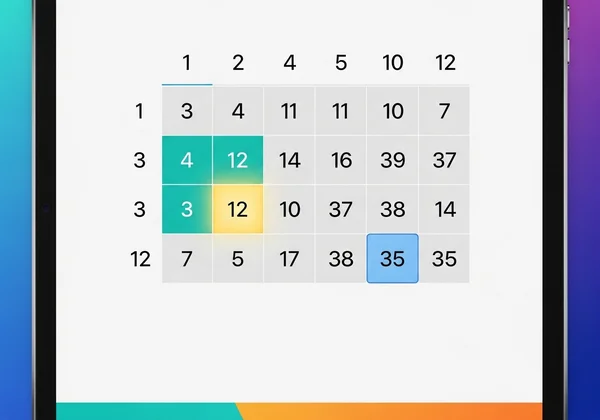What is Multiplication? A Simple Guide for Easy Learning
Hey there, future math whizzes and amazing parents! Ever felt a bit puzzled by 'multiplication'? It sounds like a big word, right? But imagine it as a super-fast math superpower for adding things up! Learning this skill is an exciting adventure, and we're here to show you how simple and fun it can be with the right tools.
To truly master your times tables, let's start with one simple idea. Instead of getting tangled up in confusing numbers, let's break it down together. Forget boring memorization and get ready to play with numbers in a whole new way. With a little guidance and some fun practice, you'll be solving these problems like a pro. Ready to begin? You can start learning multiplication on our interactive platform today!
What is Basic Multiplication? Understanding the Core Idea
At its heart, basic multiplication is simply a shortcut for adding the same number over and over again. Imagine you have four friends, and you want to give each of them three cookies. You could count them one by one (3 + 3 + 3 + 3), or you could use multiplication to find the answer much faster (4 x 3). Both ways give you 12 cookies, but multiplying gets you there in a single step!

This core concept is the first and most important step in building confidence with math. Once you see this concept as "fast adding," the fear disappears and is replaced by curiosity. It’s not a new, complicated set of rules; it’s a clever trick that mathematicians have used for centuries to make their work easier. Now, that power is in your hands.
More Than Just Adding: Understanding Repeated Addition
Let's dive a little deeper into the idea of repeated addition. Think of the times tables. When you see "5 x 4," it's really asking you to add the number 5 together 4 times: 5 + 5 + 5 + 5 = 20. Likewise, "4 x 5" means adding 4 together 5 times: 4 + 4 + 4 + 4 + 4 = 20. Notice how they both equal the same number? That’s a cool secret called the commutative property!
Understanding this connection is like getting a backstage pass to how math works. It helps you see that you don't have to memorize hundreds of random facts. Instead, you just need to understand this one simple relationship. This makes the entire math facts table feel much less intimidating and a lot more manageable for young learners.
Seeing Groups: Visualizing Multiplication Facts
Our brains love pictures, and visualizing numbers can make them much easier to understand. Instead of just seeing the numbers "3 x 4," try picturing three groups of four apples. Count them up, and you’ll see 12 apples. This method of visualizing multiplication facts turns an abstract idea into something real and tangible.

This is where a multiplication grid becomes an incredibly powerful learning tool. It organizes all the math facts in one place, allowing you to see connections and patterns you might otherwise miss. Visual learning helps lock the information in your memory far better than just repeating numbers aloud. By seeing the groups, you are no longer just memorizing; you are understanding.
Why Learning Multiplication Matters: Big Benefits for Little Learners
You might be wondering, why is learning this skill important when we have calculators on our phones? While calculators are handy, learning how to multiply builds essential skills that go far beyond the classroom. It's like learning to ride a bike—once you know how, you have the freedom and confidence to go anywhere.
Mastering the multiplication table gives children a huge advantage in their academic journey and equips them with practical skills for life. It sharpens their problem-solving abilities, improves their memory, and helps them think more critically and logically. It’s a foundational skill that opens doors to more advanced and exciting mathematical concepts. You can explore math skills with our fun resources.
Building a Strong Math Foundation for Future Success
Think of basic math skills like building blocks. Addition and subtraction are the base, and multiplying is the next essential layer. Without a solid grasp of these facts, more advanced topics like division, fractions, and even algebra become incredibly difficult. By building a strong math foundation now, you are setting your child up for future success.
This foundation isn't just about getting good grades in math class. It's about developing a "number sense"—an intuitive feel for how numbers work together. This confidence empowers children to tackle any new challenge, both in and out of school, without feeling anxious or overwhelmed. It’s an investment in their long-term growth and learning.
Multiplication in Everyday Life: Practical Skills for Kids
Multiplying isn't just for homework; we use it all the time! Understanding how this skill applies in everyday life helps children see the real-world value of what they're learning. It connects classroom lessons to their own experiences, making math relevant and exciting.

Here are a few examples:
- Shopping: If one pack of trading cards costs $2, how much will 5 packs cost? (5 x 2 = $10)
- Baking: A recipe calls for 2 cups of flour, but you want to make a triple batch. How much flour do you need? (3 x 2 = 6 cups)
- Saving Money: If you save $5 every week, how much money will you have in 8 weeks? (8 x 5 = $40)
How Multiplication Charts Make Learning Simple & Fun
Now that we know what multiplication is and why it's so important, how can we make learning it an enjoyable experience? The answer lies in using the right tools. A multiplication chart is one of the most effective resources for mastering the times tables, transforming a daunting task into a simple and engaging activity.
Modern tools have taken the classic chart to the next level. Instead of a static page of numbers, today’s learners can use interactive resources that provide instant feedback, reveal hidden patterns, and make learning feel more like a game than a chore. These tools are designed to work with a child’s natural curiosity.
Visualizing Patterns with an Interactive Times Table Chart
One of the best ways to learn is by discovering things for yourself. An interactive times table chart lets you do just that. On our platform, you can simply hover your mouse over any number, and the corresponding row and column instantly light up to show you the answer. This immediate feedback helps reinforce learning quickly and effectively.

Even better, our chart allows you to use colors to mark different squares. You can use this feature to discover amazing patterns, like how all the numbers in the 10s column end in zero, or how the numbers in the 9s column have digits that add up to 9. Visualizing these patterns makes memorization effortless. Ready to see for yourself? Try our interactive chart for free!
From Screen to Success: Practice with Free Printable Charts
While online tools are fantastic, we know that sometimes you need to practice away from a screen. That’s why a combination of digital and physical learning is so powerful. You can master the concepts online and then solidify your knowledge with offline practice. This approach caters to different learning styles and environments.
We offer free printable charts that you can take anywhere. Print a blank chart to test your knowledge on a long car ride, or use a completed one as a handy reference while doing homework. This blend of screen time and paper practice ensures that learning can happen anytime, anywhere. Get your free charts and continue your learning journey offline.
Ready to Master Your Times Tables? Your Journey Starts Here!
We’ve discovered that multiplying is just fast adding, seen why it’s a crucial skill for school and life, and explored how modern tools can make learning fun. You don’t have to rely on boring drills or stressful flashcards. With the right resources, anyone can master their times tables with confidence.
Ready to dive into the amazing world of numbers? Your journey begins right here. Our platform offers a completely free, safe, and engaging way to help you succeed. Explore our interactive chart, discover number patterns, and download printable resources for practice.
Start mastering multiplication today and turn "I can't" into "I can!"
Frequently Asked Questions About Learning Multiplication
What exactly is a multiplication chart and how does it help?
A multiplication chart, or times table grid, is a table that shows the products of two numbers. Typically, it lists the numbers 1 through 12 along the top row and left column. The box where a row and column meet contains the answer to their multiplication. It helps by organizing all the math facts in one place, making it easy to see patterns, check answers, and memorize facts visually. You can explore our online multiplication tool to see it in action.
Why is it so important for my child to learn the multiplication table?
Learning the multiplication table is crucial because it builds a strong foundation for nearly all future math concepts, including division, fractions, percentages, and algebra. It also boosts problem-solving skills, improves memory, and helps children perform mental math quickly and confidently. This skill is used frequently in everyday life, from managing money to cooking.
What are the easiest ways to help my child learn their times tables at home?
The easiest way is to make it fun! Use a mix of resources to keep them engaged. Start with an interactive tool like ours to help them visualize patterns. Play games, point out multiplying in daily activities, and use our free printable charts for offline practice. Breaking it down into smaller chunks—like focusing on one times table per week—can also make it feel less overwhelming. Combining these methods with our fun learning games makes practice feel like play.